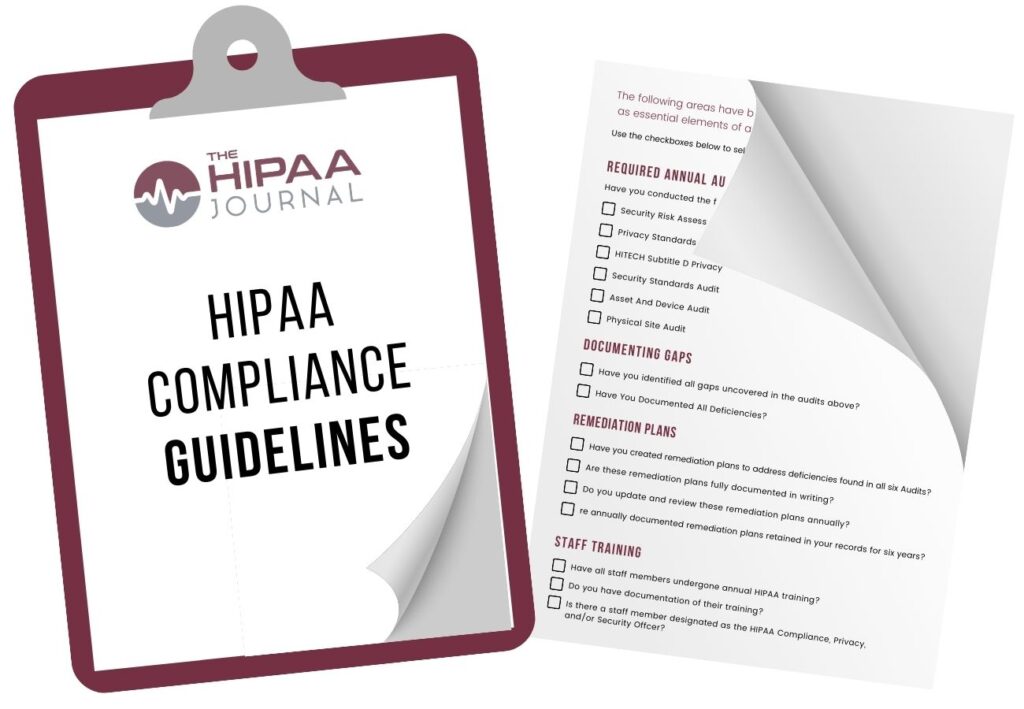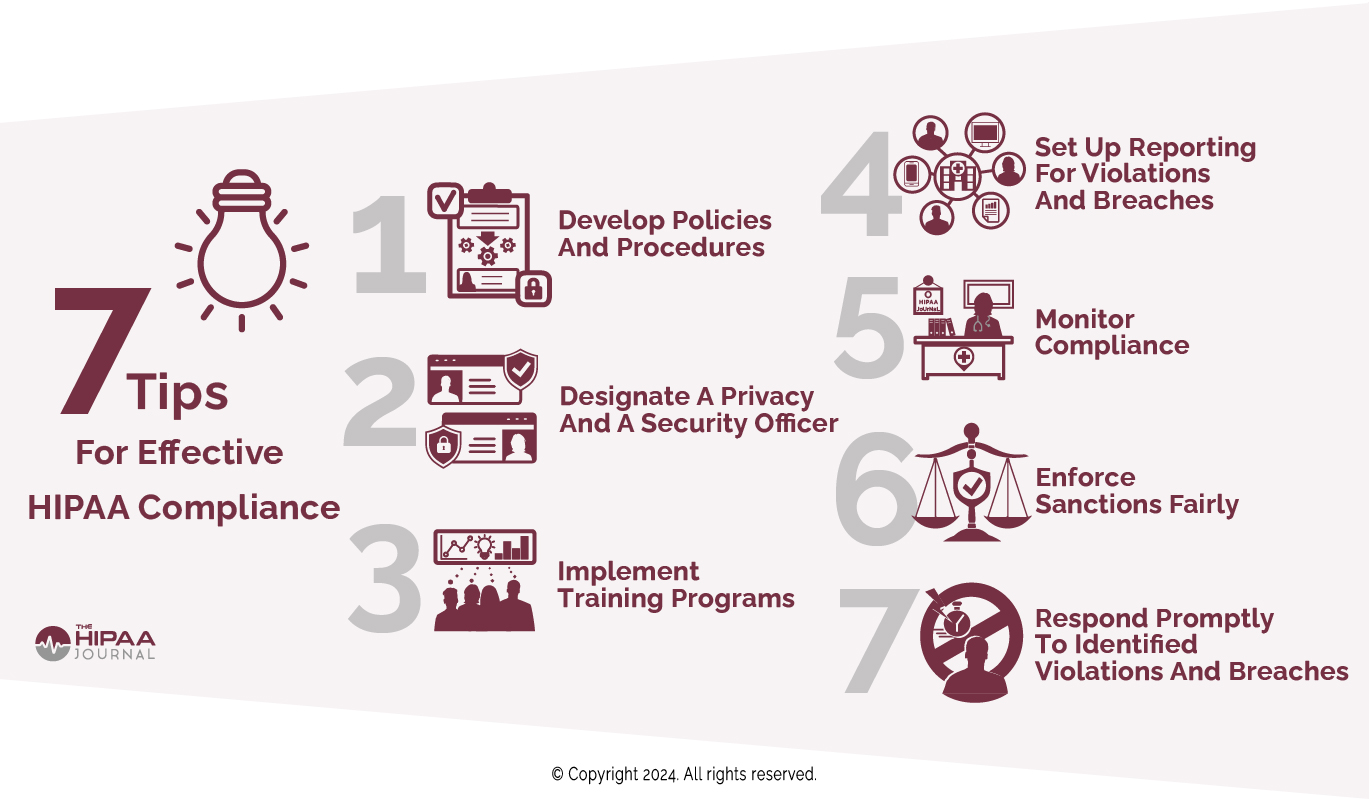HIPAA Compliance Guidelines
The HIPAA compliance guidelines provide a comprehensive starting point for HIPAA compliance in three distinct sections.
- Part One: An examination of the main aspects of HIPAA compliance, briefly exploring the various rules and regulations that healthcare professionals should be familiar with.
- Part Two: An explanation of the highly recommended framework for organizational compliance – The Seven Elements for Effective Compliance.
- Part Three: A set of HIPAA compliance guidelines in an easy-to-use checklist format so you can quickly identify any gaps in your compliance program.
 Each HIPAA compliance guideline is part of the standards for patient data privacy and security that healthcare organizations are mandated to follow. As a healthcare professional, understanding HIPAA compliance is essential for maintaining patient trust and ensuring the confidentiality of their data.
Each HIPAA compliance guideline is part of the standards for patient data privacy and security that healthcare organizations are mandated to follow. As a healthcare professional, understanding HIPAA compliance is essential for maintaining patient trust and ensuring the confidentiality of their data.
HIPAA’s Purpose and Scope
The Health Insurance Portability and Accountability Act (HIPAA) was enacted by the U.S. Congress in 1996 to address several critical objectives:
- Portability: HIPAA ensures that individuals can maintain continuous health insurance coverage, even when changing jobs or experiencing certain life events.
- Privacy and Security: HIPAA mandates the protection of individuals’ health information to safeguard patient privacy and maintain data security.
- Administrative Simplification: The Act aims to simplify healthcare administrative processes by standardizing electronic transactions and code sets.
HIPAA applies to covered entities, which include healthcare providers, health plans, and healthcare clearinghouses, as well as their business associates—third-party organizations that handle patient data on their behalf.

Get The FREE
HIPAA Compliance Checklist
Immediate Delivery of Checklist Link To Your Email Address
Please Enter Correct Email Address
Your Privacy Respected
HIPAA Journal Privacy Policy
HIPAA Privacy Rule
The HIPAA Privacy Rule establishes guidelines for protecting individuals’ medical records and other personal health information. It grants patients essential rights, such as:
- Right to Access: Patients have the right to access and obtain copies of their health records within 30 days of requesting them.
- Right to Amend: Individuals can request changes to their health information if they believe it is inaccurate or incomplete.
- Right to Request Restrictions: Patients can ask for restrictions on certain uses or disclosures of their information.
The Privacy Rule permits the use and disclosure of protected health information (PHI) for treatment, payment, and healthcare operations without obtaining patient consent. However, explicit patient authorization is required for other purposes, such as marketing or the release of psychotherapy notes.
HIPAA Compliance Guideline: Minimum Necessary Standard
Healthcare professionals must abide by the minimum necessary standard, meaning they should only access and disclose the minimum amount of PHI necessary to carry out their duties. This helps reduce the risk of unauthorized access and protects patient privacy.
HIPAA Security Rule
The HIPAA Security Rule focuses on the protection of electronic protected health information (ePHI) held or transmitted by covered entities. It requires healthcare professionals to implement various administrative, physical, and technical safeguards, including:
- Access Controls: Limiting access to ePHI to authorized personnel through unique user IDs, passwords, and other security measures.
- Encryption and Decryption: Implementing encryption to secure ePHI during storage and transmission.
- Data Backup and Recovery: Creating and maintaining data backups to ensure availability in case of emergencies.
HIPAA Compliance Guideline: Risk Analysis and Management
Healthcare professionals must conduct regular risk assessments to identify vulnerabilities and implement appropriate measures to address them. Risk management strategies should be tailored to the organization’s unique needs and risks.
HIPAA Compliance Guideline: Security Awareness Training
HIPAA requires healthcare professionals to provide security awareness training to their workforce to educate employees about potential security threats, best practices, and procedures for handling ePHI securely.
HIPAA Breach Notification Rule
A breach is an impermissible use or disclosure of PHI that poses a risk of financial, reputational, or other harm to the individual. In the event of a breach, healthcare professionals must take prompt action to investigate and mitigate the risks.
HIPAA Compliance Guideline: Breach Assessment and Reporting
If a breach occurs, healthcare professionals must conduct a risk assessment to determine the probability of compromised data and the potential harm to patients. If the risk is significant, they must report the breach to affected individuals, the Office for Civil Rights (OCR), and, in some cases, the media.
Mitigating Breach Risks
To minimize breach risks, healthcare professionals should proactively implement security measures, conduct regular risk assessments, and develop an incident response plan to address potential breaches effectively.
HIPAA Enforcement and Penalties
The OCR is responsible for enforcing HIPAA compliance. It conducts investigations into complaints and breaches, audits covered entities and business associates, and imposes penalties for non-compliance.
Civil and Criminal Penalties
HIPAA violations can lead to severe consequences, including civil and criminal penalties. Civil penalties can range from $100 to $50,000 per violation, depending on the level of negligence. Criminal penalties may result in fines up to $250,000 and up to ten years of imprisonment for intentional PHI disclosure.

Get The FREE
HIPAA Compliance Checklist
Immediate Delivery of Checklist Link To Your Email Address
Please enter correct email address
Your Privacy Respected
HIPAA Journal Privacy Policy
HIPAA Compliance Guidelines : Best Practices to Prevent Violations
To maintain HIPAA compliance and safeguard patient data effectively, healthcare professionals should consider the following best practices:
- Regular Training: Provide ongoing training to all staff members to ensure they stay informed about HIPAA regulations and best practices.
- Secure Communication: Use encrypted channels for sharing sensitive patient information to prevent unauthorized access.
- Secure Technology: Implement robust security measures for data storage, transmission, and disposal, including encryption and access controls.
- Risk Assessment: Conduct regular risk assessments to identify potential vulnerabilities and address them promptly.
- Compliance Audits: Perform internal audits to assess the organization’s compliance with HIPAA guidelines and make necessary improvements.
By adhering to HIPAA compliance guidelines, healthcare professionals can uphold patient trust, protect sensitive data, and contribute to the overall improvement of healthcare data security and privacy. HIPAA compliance is an ongoing process, and continuous efforts are required to meet the evolving security challenges in the healthcare industry.
 Please use the form on this page to receive a free copy of the HIPAA Compliance Guidelines that are provided in an easy-to-use checklist format.
Please use the form on this page to receive a free copy of the HIPAA Compliance Guidelines that are provided in an easy-to-use checklist format.
Seven Elements For Effective Compliance
In 2011, HHS published “The Seven Fundamental Elements Of An Effective Compliance Program”. This has been slightly amended it to be more relevant to HIPAA compliance in 2023. Here is a summary of the elements, outlined in more detail below:
- Develop policies and procedures so that day-to-day activities comply with the Privacy Rule.
- Designate a Privacy Officer and a Security Officer.
- Implement effective training programs.
- Ensure channels of communication exist to report violations, and breaches.
- Monitor compliance at floor level so poor compliance practices can be nipped in the bud.
- Enforce sanctions policies fairly and equally.
- Respond promptly to identified or reported violations, and breaches.
See each element in more detail below.

Element 1: Why Privacy Rule Policies and Procedures?
Although HIPAA compliance consists of complying with all relevant Administrative Simplification Regulations, implementing Security Rule and Breach Notification standards is generally an organizational process not connected with cultivating a culture of compliance. Additionally, the most common HIPAA violations are attributable to failures to comply with the Privacy Rule.
However, it is no longer sufficient to develop policies and procedures that only address permissible uses and disclosures, the minimum necessary standard, and patients’ rights. Covered Entities should ensure Privacy Rule policies and procedures include how to explain to patients what PHI is (and what it isn’t), how to verify an individual’s identity, and how to record requests for privacy protections.
Element 2: The Roles of HIPAA Compliance Officers
It is interesting that the HHS’ Office of Inspector General placed this “tip” in second place after the development of policies and procedures. This would imply the roles of HIPAA compliance officers are to train members of the workforce, monitor compliance, and enforce the organization’s sanctions policy. However, there is quite a lot more involved in being a compliance officer.
In most cases, the HIPAA Privacy Officer will be the point of contact for members of the public and members of the workforce that want to report privacy concerns. Security Officers are generally more responsible for conducting risk assessments, ensuring security solutions are configured properly, and training members of the workforce on how to use the solutions compliantly.

Get The FREE
HIPAA Compliance Checklist
Immediate Delivery of Checklist Link To Your Email Address
Please enter correct email address
Your Privacy Respected
HIPAA Journal Privacy Policy
Element 3: What Makes an Effective Training Program?
The effectiveness of the training provided to members of the workforce can make the difference between ticking the box of compliance or cultivating a culture of compliance. To make Privacy Rule training effective, members of the workforce must understand what PHI is, why it has to be protected, and the consequences to patients, employers, and themselves of HIPAA violations.
Security Rule training must be even more focused on the consequences of taking shortcuts, circumnavigating safeguards, and failing to alert managers of a data breach for fear of “getting into trouble”. One way of achieving this is to ask members of the workforce to run personal online credentials through the HIBP database to illustrate the importance of unique, complex passwords.
Element 4: The Importance of Two-Way Communication
While policy making and training has to come from the top down, it is important that any channels of communication relating to HIPAA compliance are also bottom up – not only to raise compliance concerns or report HIPAA violations, but also to provide feedback on what works and what doesn’t on the ground floor, and what new challenges are facing frontline members of the workforce.
This is why it can be important – when resources allow – to have a compliance team consisting of team members that have worked in or have knowledge of how different departments operate. For example, a compliance team consisting solely of lawyers and IT managers may not appreciate the difficulty of protecting the privacy of PHI in front of a grieving family mourning a recent loss.
Element 5: How Most Poor Compliance Practices Develop
Most poor compliance practices result from well-meaning intentions – for example, to “get the job done” or provide a good service to a patient’s family. When minor violations are allowed to continue, poor compliance practices can develop into a culture of non-compliance. This is why it is important identify and address poor compliance practices at the earliest opportunity.
While it is important to have eyes on compliance at floor level, it is also important not to take eyes off compliance at higher levels. Busy managers and senior managers can also be guilty of taking shortcuts with compliance or ignoring non-compliant activities because they do not have the time to “sort it out” – when, in truth, the failure to take action is a failure of management.
Element 6: The Best Sanctions are Not Always Disciplinary
Sanctions policies can often be overwhelming documents threatening all manner of disciplinary actions for non-compliance from warnings to suspensions, to termination of contract and loss of license. Some even include the maximum federal penalties for violations of §1177 of the Social Security Act (up to ten years in prison and up to $250,000 in fines).
Although these sanctions may have to legally be included in a sanctions policy, making them the focus of attention is not necessarily the best way to cultivate a culture of compliance. The threat of additional training is often sufficient to create and maintain a compliant workforce – especially if whole teams have to attend refresher training due to the non-compliance of an individual!
Element 7: Responding Quickly is the Key to Compliance
One of the keys to cultivating a culture of compliance is to respond to queries, issues, complaints, reports of violations, and data breaches as quickly as possible. Responding quickly to any type of communication demonstrates a commitment to compliance and an eagerness to ensure – once a compliant workforce is achieved – the compliant state is maintained.
Responding to queries, issues, complaints, etc. would ordinarily be the responsibility of compliance officers (or teams), but this can lead to the compliance officers being overwhelmed. Consequently, it may be necessary for managers and senior managers to take some responsibility for monitoring compliance and responding to workforce or patient communications.
 As stated above we offer a full set of HIPAA compliance guidelines in an easy-to-use checklist format. Please use any form on this page to receive a free copy of the HIPAA Compliance Guidelines PDF.
As stated above we offer a full set of HIPAA compliance guidelines in an easy-to-use checklist format. Please use any form on this page to receive a free copy of the HIPAA Compliance Guidelines PDF.

Get Our FREE
HIPAA Compliance Guidelines PDF
Immediate Delivery of Guidelines Link To Your Email Address
Please Enter Correct Email Address
Your Privacy Respected
HIPAA Journal Privacy Policy
HIPAA Journal featured on







